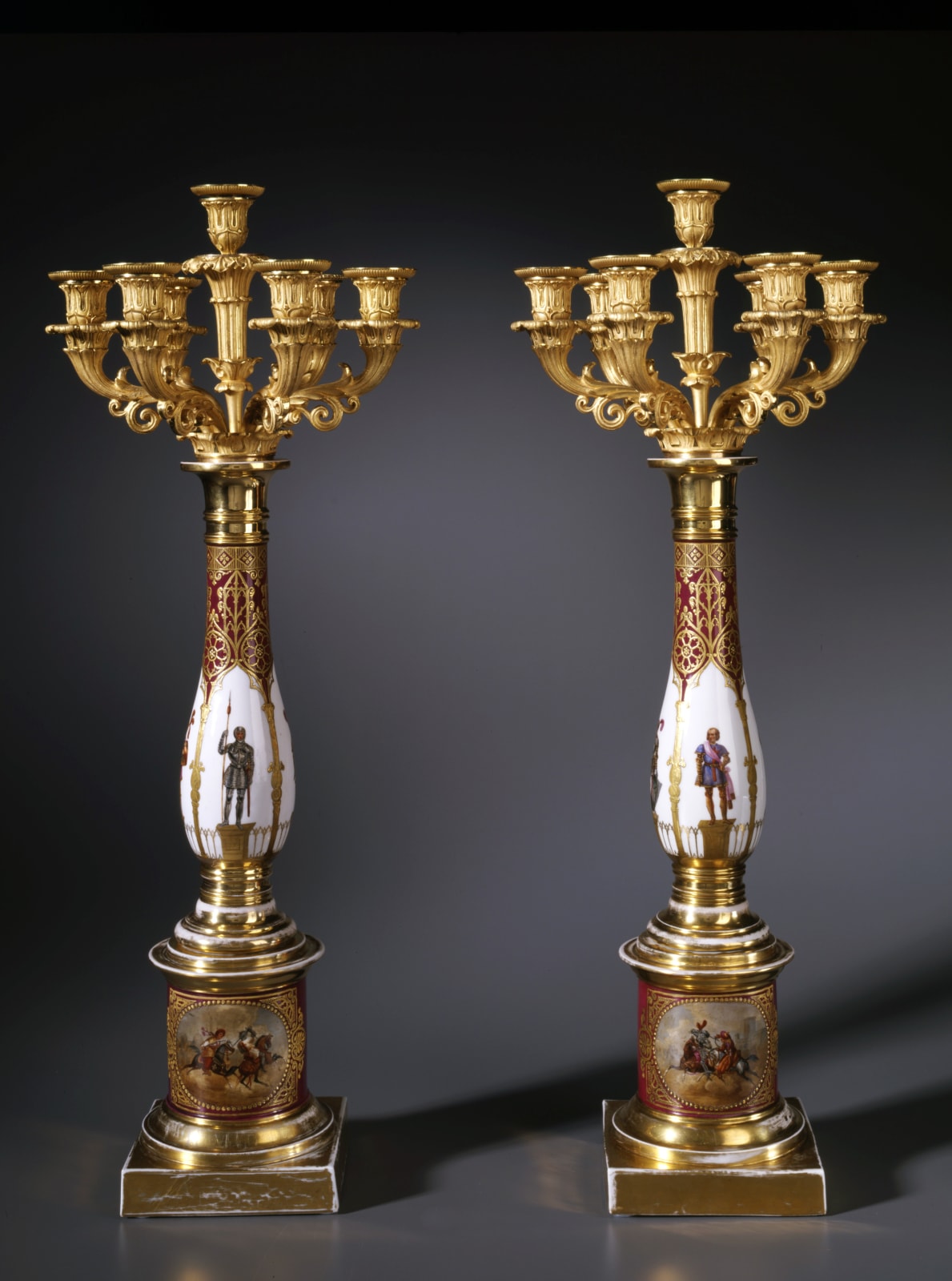Unknown
An imposing pair of Restauration gilt bronze and gilt and polychrome painted porcelain seven-light candelabra, each surmounted by a central tapering fluted candle branch headed by a vase-shaped candleholder with foliate drip-pan surrounded by six scrolled and curved fluted candle branches issuing vase-shaped candleholders, the porcelain shaft of baluster form painted at the top with gilt tracery over a pink ground above four cartouches divided by gilded columns within which stand a crusader, each individually painted figure dressed in either full or partial armour, some wearing a plumed helmet, the majority decorated with a red cross and either carrying a shield and/or a weapon, all standing upon a plinth flanked by Gothic style tracery, the circular spreading foot upon a gilded plinth, each decorated within two oval frames combat scenes between Western and Eastern warriors, both mounted on horseback and set against a backdrop of further battle scenes and in three a crusader's fortress and in the fourth a domed tower, the plinth on a spreading foot on a square gilt base
The bronze: Paris. The porcelain: European, date circa 1820-30
Height 77.3 cm, diameter of top 30 cm, the base 16 cm. square. each.
The design of the candle branches is typical of the Restauration style following on from the Empire dating to the years when Napoleon ruled France and much of Europe. Although the painted porcelain is of a different style, the imagery relating to the Crusades during the 11th-13th centuries was one that had great political relevance to West European society during the first half of the nineteenth century. The subject also had artistic relevance to the great Romantic artists and writers who sought inspiration from the Orient. The Paris salon artists tended to paint a number of Eastern battle scenes such as Antoine-Jean Gros' 'Battle of Aboukir', 1806 as well as his 'Bonaparte Visiting the Victims of the Plague at Jaffa', 1804, which aimed to emphasize Napoleon's Imperial power in the East. Artists and writer were also attracted by the Romantic pursuit of a vanished part of Eastern history. The strength of feeling induced by the exploits of the Medieval crusaders in the Holy Land continued apace during the 1820's as witnessed by the novels of Sir Walter Scott. Interest in the Crusades may also have been inspired by Greece's battle for independence from the Turks, as portrayed in the Romantic poetry of Lord Byron (who also died fighting on behalf of Greece, 1824). Eugène Delacroix, the great Romantic painter and admirer of Byron was inspired to paint 'The Massacre at Chios', 1824, portraying the suffering of the Greeks at Chios at the hands of the Turks. While a more direct reference to the Crusades was manifest in Delacroix's 'The Crusaders Entering Constantinople', (commissioned in 1838 for Versailles and completed 1840). Interest in the Crusades was not restricted to canvas but also inspired porcelain painters including a pair of Sèvres vases, circa 1820-30 sold by this gallery (Richard Redding, "25th Anniversary Catalogue", 2002, p. 297).
The Crusades were military expeditions undertaken by European Christians intending to conquer the Holy Land from the Muslims. Eight major expeditions were organised between 1096 and 1270, coinciding with a period in which Western Europe was expanding its economy and increasing its military forces. The Crusades were part of a broad Christian expansion movement. Kings, nobles and thousands of knights, peasants and townsfolk took part. Their aim was to gain permanent control from the Muslims of Palestine and to protect the Byzantine Empire, a Greek Christian Empire centred in South Eastern Europe, from the Muslims. Although religious motives may have dominated at first, worldly aims were never absent and thus many crusaders also fought to increase their power, territory and riches. The outcome of the Crusades was ultimately one of failure, yet despite this and the ensuing destruction of innocent lives the Crusades themselves were later seen in a romantic light and as such inspired a wealth of nineteenth century art.
